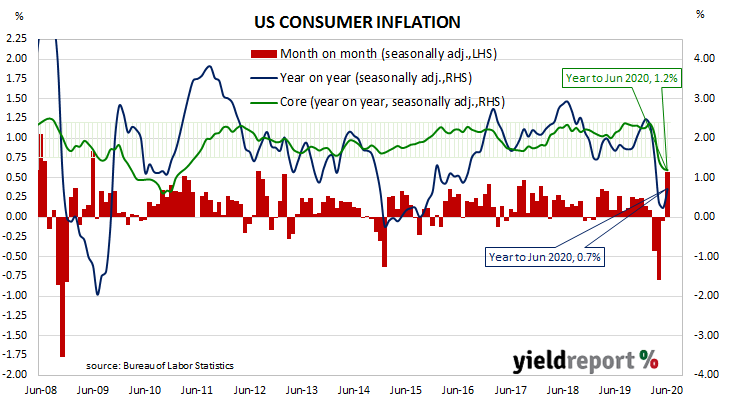Summary: June CPI increases in line with expectations; both headline and core figures back above zero for month; fuel prices, car insurance premiums up; food, especially meats, up; small rent increases suggest core inflation likely weak “for some time”.
The annual rate of US inflation as measured by changes in the consumer price index (CPI) halved from nearly 3% in the period from July 2018 to February 2019. It then fluctuated in a range from 1.5% to 2.0% through 2019 before rising above 2.0% in the final months of that year. “Headline” inflation is known to be volatile and so references are often made to “core” inflation for analytical purposes. Substantially lower rates for both measures have been reported since March.
The latest CPI figures released by the Bureau of Labor Statistics indicated seasonally-adjusted consumer prices increased by 0.6% on average in June. The rise was in line with expectations and in contrast with the 0.1% decline recorded in May. On a 12-month basis, the inflation rate accelerated from May’s rate of 0.2% to 0.7%.
Core inflation, a measure of inflation which strips out the volatile food and energy components of the index, increased on a seasonally-adjusted basis by 0.2% for the month. The increase was more than the 0.1% rise which had been expected and a reversal of May’s -0.1%. However, the seasonally adjusted annual rate remained at 1.2%,
ANZ senior economist Cherelle Murphy said, “These data provided some hope to markets that disinflationary pressures are starting to abate.”
Short-term US Treasury bond yields increased while longer-term yields remained steady. The 2-year yield increased by 4bps to 0.17% while 10-year and 30-year yields finished the day unchanged at 0.62% and 1.31% respectively.
In terms of likely US monetary policy, expectations of any change in the federal funds rate over the next 12 months remained negligible. OIS contracts for July implied an effective federal funds rate of 0.078%, a little under the current spot rate.
The largest influence on headline results is often the change in fuel prices. In June they increased by 11.7% on a seasonally adjusted basis, contributing around +0.25% to the total change for the month. The next largest source of inflationary pressure came from a 5.1% rise in vehicle insurance premiums, partially reversing a sizable fall in May. Inflation in food, especially meats continued.

